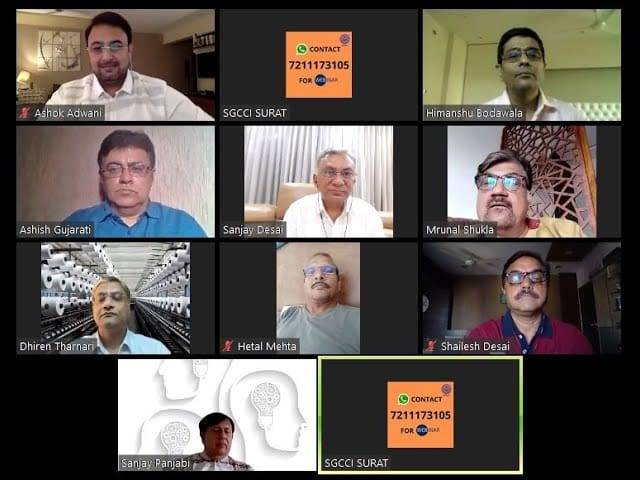Discussion point is Weaving & Embroidery Precautions of Machinery During & After Lockdown
Webinar discussion with Mr. Ashok Adwani, Mr. Sanjay Desai and Mr.Ashish Gujarati
Mr. Himanshu welcomed all the participants and said “whenever Surat faces problems like Corona we come back with double enthusiasm, whether it is the Floods in 1994 or earthquakes in 2001, we always stay strong and fight against it”. He proceeded with introducing the guest and also welcoming them to the webinar. Mr. Ashish Gujarati started by giving a brief about the TFO (twisting machine) now and after the lockdown. Then he mentioned about the market situations and opportunities of Surat fabric and technical textile industries.
Mr. Ashok Adwani, started by congratulating SGCCI for conducting such amazing webinars and discussing crucial topics in current day scenario. He talked about the after lockdown situations of the factories, measures to maintain the factories and the scope or future of the textiles after the lockdown. “There is a saying “precaution and prevention are better than cure”, the factory managements should have taken accurate measures before shutting down the factories”, said Mr. Adwani. Then he proceeded by saying that India has the best economy and explained that the textile industry in India is the most self-sufficient country in the world. If we are talking about fibres, India is the largest producer of cotton fibre i.e. 98% of the production is done in India. We are the 2nd largest producers of manmade and silk fibres in the world after China. In jute production we are the largest producers. The quality of fabrics we produce is way better than China. After the lockdown it may take time to come out of the crises but the future of India is much brighter. Mr. Sanjay Desai spoke about the current and after lockdown scenario of water jet loom. He gave a very informative brief about the measures and maintenance for keeping the waterjet loom safe and working.
MMF mainly used for technical textiles, Surat have great opportunity.
Discussion video link :
Few Q & A from participants :
Q. Are the precautionary measures settings same or different for shuttle less looms (rapier loom and water jet loom)? What are the precautionary measures for cotton weaving on rapier loom and what setting should be done for PC blend weaving?
A. With factory point of view, the measures more or less are the same for all the factories, just the weft insertion chain is a little different in water jet looms. Whereas when we talk about cotton, some important measures have to be taken i.e. cotton catches humidity, so it need dehumidifying plants and also air conditioner to control the humidity and so the yarns do not catch any moisture.
Q. In the current scenario it is not possible to go to the factory and take the measures, what should one do?
A. You can definitely take measures once the factory reopens.
Q. In present circumstances many health care products will be priority and important, what are woven medical textiles products possible using modern weaving machine, what steps are needed for such product development?
A. Many people had inquired, asking to send or supply them the mask making machine so we did a research on this. The only problem we are facing is that the machines are available but the fabric with different blends which used in a non-woven fabric is not available in India.
Q. Which machines are used for medical textiles/ technical textiles, can water jet looms be used?
A. Technical textiles are a vast subject and it completely depends on the product. In technical textiles pre weaving and post weaving plays a very important role, so the product that is to be produced should be decided first. For Apron we can make in water jet , for mask different machine and Melt blown fabric is required. Woven has good scope in India and Surat is already manufacturing it.
Q. How does one protect the polyester nylon that is been lying in the factory due to current situation, what measures should one take to avoid piles on yarns?
A. one may not be able to avoid it but can try to save it by covering it with fabric so that it does not catch humidity.
Q. What precautions should one take while starting the rapier loom with electronic jacquard after few months which are not covered with anything?
A. Hot blower should be used to clean the parts to remove the moisture from those parts so it will not be damaged.
Q. What is the status of banana fibres or other fibre based on agro future, are further any new machinery coming as opportunity for Surat weavers?
A. A lot of research is being going on for organic fibers, banana fibre is one of them. More research needs to be done for commercial use.
Q. If we want to start our unit do we have to take official permission, and our staff stays at the unit itself?
A. If you want to start the production in the current scenario, the products should be medical textiles i.e. masks, apron, etc.
Q. Is fabric coating and lamination possible in Surat?
A. Yes we have so many coating and laminating plants in Surat.
Q. Should we cut off the power of the units of water jet units?
A. As I have mentioned earlier that the power should not be cut because the machines should not catch any moisture.

